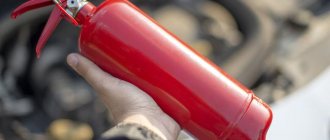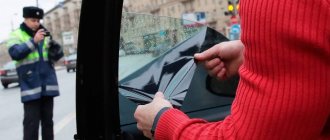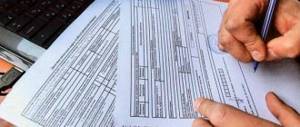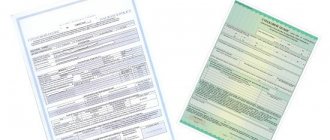Roads in Russia are a natural threat to the integrity of the car. Unexpected holes, pieces of iron protruding from the asphalt, spilled bitumen and other dangers await drivers in a variety of places.
But even an ideal coating does not guarantee the preservation of the external characteristics of the car. A stray stone thrown from under the wheels or bed of the truck in front of you can crack your windshield. Typically, cracked glass does not significantly interfere with the driving process. But is it possible to pass inspection with a crack in the windshield?
GOST requirements
The traffic rules are silent about such a defect. However, GOST 51709-2001, which regulates vehicle requirements, mentions a crack in the windshield on the driver's side. The document declares that such a defect is a violation of the state standard, and the inspection of the car due to a peculiar fault will be suspended until it is removed.
Of course, a complete replacement of the mentioned element cannot be called an optimal solution. The service station, equipped with modern technological tools, is capable of carrying out high-quality glass repairs without replacing it.
The metrological charter adds that the light transmitting performance of the front glass must be within at least 70%. Even if the light transmission of the passenger side varies towards a decrease, it is unlikely that it will be possible to pass inspection by a technical inspection operator.
One of the forms of deliberately reducing light transmission is glass tinting, but, again, within the mentioned 70%. However, a crack in the glass in this case will further impair the driver’s vision of the road, which will lead to a negative result during the technical inspection. Although, the modern world has found a loophole on how to pass a technical inspection with a crack in 2021, which will be discussed a little below.
Which cracks are unacceptable?
You will not be able to pass the inspection if:
- The triplex cracked on the driver's side (on the left for left-hand drive cars and on the right for right-hand drive cars).
- The crack is located in the area where the windshield wiper blades operate, regardless of its size. This is due to the fact that wipers can cause it to spread.
- Its length exceeds 157 mm regardless of location.
- Less than 70% of the light passes through the defective zones of the triplex, which makes it difficult for the driver to study the road situation.
- The area covered by a mesh consisting of small cracks occupies more than 60% of the passenger half of the auto glass.
When assessing the technical condition of the car, the inspector must determine whether the defect in the windshield affects visibility, or whether it is only cosmetic. If it impairs visibility, you will not be able to pass the inspection.
Causes of cracks
Breaks in the windshield will not surprise anyone, especially if the car is used far from highways, highways and well-maintained city highways. Side and rear windows suffer much less even when on roads covered with gravel and other small stones. The main factors for the occurrence of coating faults are considered to be:
- Stone. The high speed of the vehicle leads to the ejection of small stones from under the wheels, which fall into the car behind. Taking into account the inertia of the stone's flight and the associated speed of the rear car, you can easily make sure that the stone will easily break through the observation triplex.
- Large icy pieces of hail, supplemented by the wind, are a strong deformer of the front of the car.
- A car released from the assembly line cannot always boast of the correct body structure, which affects uneven pressure in the cabin. Even a strong slam of a car door can cause a crack in the windshield.
Less important, but deforming factors, seem to be the car going out on a winter road after washing the car with hot water, scratching the triplex with old wipers or a rough hand brush. Unnoticeable faults eventually turn into large cracks. Some car owners treat such a violation without due attention, which results in a failed technical examination.
Causes of damage and impact on driving safety
Damage to the windshield is considered the most common defect, since it occurs there much earlier than on the side or rear windows of the car. There are many reasons why a crack can occur.
These include:
- Manufacturing defect.
- Weather phenomena (mainly hail, falling objects due to wind).
- Using worn windshield wipers.
- Violations during manual cleaning.
- Rapid temperature changes.
- Incorrect load distribution as a result of body design.
- Acts of vandalism.
The windshield can also break during an accident, even if the rest of the car is intact. In this situation, the force of the impact directly affects the size of the crack.
It is important to know! The danger of driving with a cracked windshield depends on how large the defect is. If the damage is minor, it will have little effect on driving as it will not interfere with your vision. If the crack is large, it may interfere with driving and limit visibility.
When considering whether you can drive with a cracked windshield, it is important to remember that minor damage can be magnified by external factors. These include high and low temperatures, poor road quality and operation in adverse conditions.
How to Pass an Inspection with a Cracked Windshield in 2021
There are two ways to get a positive result during a technical inspection of a car with a crack in the glass - illegal and completely legal, but with certain conditions.
The first method is due to the illegal acquisition of a diagnostic card from one of the companies, of which there are a dozen. However, its employee will not give a full guarantee that the issued document will be registered by the EAISTO automated database. Checking the latter by the insurance manager will reveal a false diagnostic card, which will result in a refusal to issue an insurance policy. Only an official examination will save the owner of the car.
Small cracks on the windshield during technical inspection, located in front of the passenger seat, especially those located in certain places and corners, will not prevent the owner of the vehicle from appearing in front of the technical inspection operator. The same applies to coating defects that are not located in the area where the windshield wipers operate.
However, rough repairs and manual gluing will bring disappointment to the owner of the car during its examination.
Additional factors for operator failure are:
- presence of a fracture of more than 16 cm in front of the passenger seat;
- the presence of a fine network of chips in front of the passenger, occupying more than 60% of the surface.
The listed comments do not apply to tinted surfaces.
Who is entitled to a deferment?
On March 1 of this year, changes to the law on technical supervision were supposed to come into force. The changes to the law are designed to eliminate the gray market for purchasing diagnostic cards - now motorists will have to actually visit inspection stations. However, neither the stations nor the services that are supposed to monitor the inspection are ready to implement the new rules. Ongoing controversy over the inadequacies of the new technical inspection system has led the Russian government to suspend enforcement of the strict “Technical Inspection Law.” And March 1, 2021. The Russian Union of Motor Insurers has given a clear explanation of which car owners can take advantage of the “transition period” and not carry out a technical inspection.
According to Order No. 275 of February 27 of this year, benefits can be used by owners of cars whose diagnostic card expires from February 1. until September 30, 2021. However, not everything is so smooth! The grace period does not apply to the following categories of vehicles:
- Cars that are 4 years old undergo their first technical inspection and receive a diagnostic card.
- If the car is used as a taxi, then, according to current legislation, the owners of such cars must undergo a technical inspection once every 6 months.
And on October 1, 2021, according to the government, stations will be able to comply with all the requirements of the new law on technical supervision. Let us remind you what the inspection procedure should look like in the new version:
- The diagnostic card is issued online in a special program developed by the Ministry of Internal Affairs and Administration. The principle of its operation is that, in addition to information about the technical condition of the car, the same program sends photographs of the car when entering and leaving the station along with the coordinates. So far, according to gas station operators, the system is “hanging.”
- Insurers must obtain information about the presence/absence of a valid diagnostic card from the same scheme when applying for compulsory motor liability insurance. However, since March 1, 2021, serious problems have arisen with the system, according to executives of large insurance companies. It is not possible to obtain information.
Starting March 1, 2021, insurance companies will be able to pursue claims against the at-fault driver if their vehicle failed inspection at the time of the accident. But there are some caveats here. Recourse - that is, reimbursement of the amount of compensation that the insurer paid to the victim - can only be claimed by the owners of cars, trucks and buses. Car owners can file a recourse claim only if the accident was caused by a technical defect of the car (brake failure, etc.). If the accident was caused by a traffic violation or the driver was not in control of the vehicle, you cannot file a claim for punitive damages.
To date, changes have already been made to Article 12.5 of the Code of Administrative Offences: for exceeding the deadline for passing a technical inspection, a fine of 2,000 rubles is provided. However, this article will come into force on March 1, 2022. Therefore, the traffic police officer does not have the right to impose a fine or check the presence/absence of a valid vehicle inspection card. Don’t worry about fines just yet, because passing a vehicle inspection “according to the new rules” is still quite difficult! We will monitor the situation with the technical inspection and registration of the OS policy and will inform you about important nuances as soon as they appear!
What to do if you haven’t passed MOT
A negative examination result will bring little joy to anyone; a windshield costs money. However, by contacting a service center you can significantly save on repairing the frontal part. Now there are many technologies that will make the old triplex almost new. These procedures will help you attend a technical inspection without a crack on the front triplex, such as:
- cleaning the fault from dust and wet dirt;
- processing of all rays of chips;
- filling them with a special polymer substance;
- sealing the chip;
- ultraviolet treatment, polymerization;
- surface polishing, cleaning of working agent residues.
The work carried out will facilitate the passage of a technical examination and the legal receipt of the necessary diagnostic card.
To the above it is worth adding the following prohibiting factors:
- installation of mirror glass;
- tinting with a decrease in light transmission of more than 30%;
- the presence of various stickers and images on the front surface.
Rear view surfaces do not fall under this category, so they will not affect the inspection.
Other glass features that make it difficult to pass MOT
The standard condition of the front glazing does not yet provide complete confidence in passing maintenance.
Important requirements are also:
- lack of mirrored front windows and mirror film;
- the light transmittance of the wind surface after tinting must be at least 75%;
- light transmission of the front door glass is at least 70%;
- lack of stickers on the front surface.
Graphic elements on glass are often found. According to the rules, they are only allowed on the rear window or side of the rear doors.
Prevention of windshield defects
Avoiding stones hitting the front of the car and temperature changes is the primary task of every car owner. This will help the driver pass the technical inspection and a crack will not appear in the windshield. Some useful tips will help with this, for example:
- do not drive behind heavy bulky vehicles, from under the wheels or body of which solid particles fly out, contributing to the destruction of the triplex;
- carry out an inspection of wipers, replace old worn ones with new ones;
- do not make long stops in areas of heavy traffic;
- do not make sudden changes in temperature;
- systematically check the integrity of the front covering.
The discovery of a small crack should be accompanied by restoration of the integrity of the triplex.
Photo recording during technical inspection
As already mentioned, one of the new requirements for technical inspection is the mandatory photomontage of the car before and after the procedure. This measure is necessary primarily in order to reduce the number of falsified diagnostic cards in the future.
To date, the requirements for this procedure have already been approved by the Ministry of Transport of the Russian Federation. When an accredited operator carries out an inspection, two photographs must be taken:
- Photo of the front of the car before the inspection began.
- Photo of the rear of the car after inspection.
Photos must be in color, with easy to read license plates, make and model of vehicle, and vary in color. In addition, the photo file must contain information about the date, time and location of the inspection. The latter is carried out using the GLONASS system. Finally, the file is signed with the enhanced qualification signature of the operator who carried out the verification.
After completing all of the above steps, the information is sent to the EAISTO electronic system, where it will be stored for 5 years. If necessary, information can be transferred based on an electronic request. Moreover, basic information can be obtained not only by specialized structures, but also by ordinary users.
Brakes
Quite often, it is their work that raises complaints from employees of the diagnostic station. Either the handbrake doesn’t hold tightly enough, or uneven operation of the mechanisms is detected, or the notorious “sorcerer” on old cars without ABS is doing a disservice. Without a brake test, it is quite difficult to be sure that you will pass this part of the test without problems, but at least you can increase your chances of success.
The more frequently and thoroughly your brakes are serviced, the more likely it is that problems will not arise. But even in this case, it would not be superfluous to check for yourself how reliably the parking brake holds the car on an ascent or descent. If the design provides for adjustment of the rear brakes, then it is worth checking it and, if necessary, performing it. Bleeding the brakes may also be useful, especially if it has not been done for a long time. You will have to “dig deeper” (develop guides, restore calipers, change pads or discs, handbrake cables) if the car still fails MOT because of the brakes.
For what reasons might repairs be needed?
If you find a crack or small chip, do not delay repairs. Small defects can increase in size or cause an emergency. In addition, such a defect interferes with uniform heating and interferes with (sometimes jams) the operation of the wipers.
Modern technologies make it possible to repair glass that has damage no larger than 1 cm. All defects above this size cannot be repaired. In this case, only a complete replacement will help.











